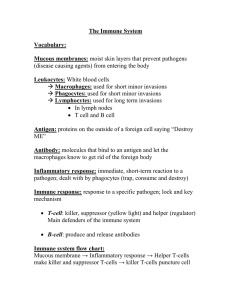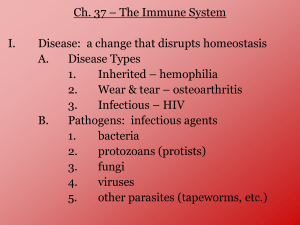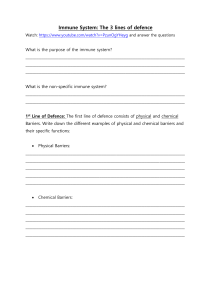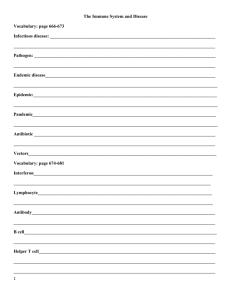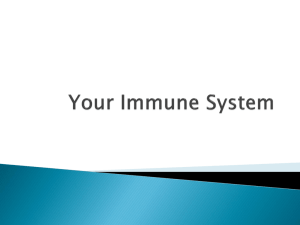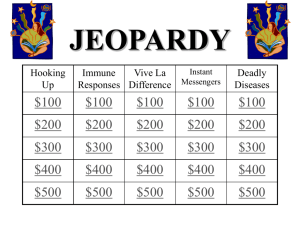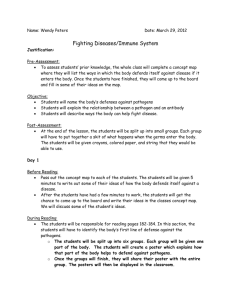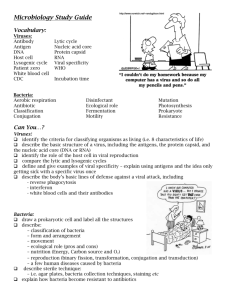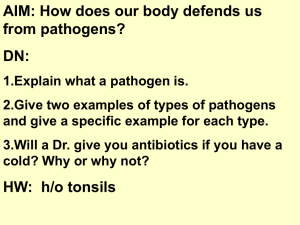Defense Against Infectious Diseases
advertisement
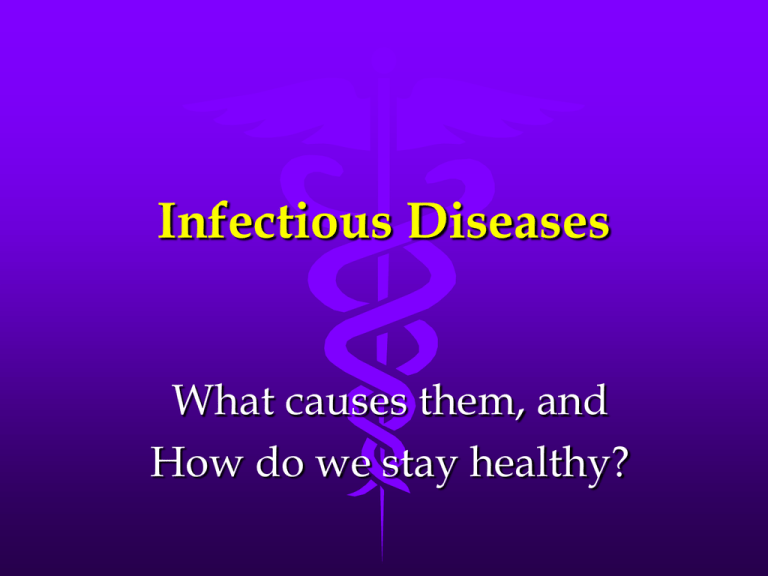
Infectious Diseases What causes them, and How do we stay healthy? Standard Organisms have a variety of mechanisms to combat disease. 10: • 10A -- Students know the role of the skin in providing nonspecific defenses against infection • 10B -- Students know the role of antibodies in the body’s response to infection • 10C -- Students know how vaccination protects an individual from infectious diseases • 10D -- Know the important differences between bacteria and viruses (i.e.: their requirement for growth and replication, the body’s primary defenses against bacterial and viral infections, and effective treatments of these infections) • 10E -- Know why an individual with a compromised immune system (ex: a person with AIDS) may be unable to fight off and survive infections by microorganisms that are usually benign • 10F -- Students know the roles of phagocytes, B-lymphocytes, and T-lymphocytes in the immune system What is a Virus? • Nonliving particles that have a nucleic acid core and a protein-containing capsid. • Cause disease by disrupting the body’s homeostasis (balance). • Don’t exhibit all life criteria: Don’t carry out respiration No growth or development (all they can do is replicate) • Host Cell – where a virus replicates • Cannot be killed by antibiotics (medicines) Viral Structure: T4 Virus – E. Coli HERPES HIV Influenza – The common Cold Viral Replication – Lytic Cycle 1. Attachment – attaches to host cell 2. Entry – injects nucleic acid into host cell 3. Replication – host uses it energy to replicate viral nucleic acid 4. Assembly – New viruses made (in 30 minutes, 200 new viruses) 5. Lysis and Release – Host cell breaks open, and virus particles are released What is Bacteria? • Small cell with all the structures necessary to carry out its life functions. • 2 types of Bacteria: 1. Archaebacteria – inhabit extreme environments 2. Eubacteria – live almost everywhere else. (heterotrophs, photosynthetic autotrophs, and Chemosynthetic autotrophs) Structure of Bacteria • Prokaryotic Cells (typically) • Contain: Chromosomes – Single DNA molecule (no nucleus) Cell Wall – shape and support Plasma Membrane – regulates entry and exit Pilus – help stick to a surface and bridge for DNA exchange Flagellum – Whip-like tail for locomotion Ribosomes – helps in protein formation Bacterial Reproduction • Asexual Binary Fission – 1. Chromosome replicates, attaches to plasma membrane 2. Cell grows and splits • Sexual Reproduction Conjugation – Transfers all or part of chromosomes to another bacteria through its pilus How do bacteria make you sick? • Produce disease in one of 2 ways: 1. Damage cells and tissues of the infected organism directly, by breaking down the cells for food. 2. Release toxins (poisons) that travel throughout the body interfering with homeostasis of the host. Defense Against Infectious Diseases How do we stay healthy? What is an Infectious Disease? • Disease = a change that disrupts the homeostasis in the body • Pathogens = disease causing agents (what makes you sick) Our Bodies Defense Mechanisms: • Skin – the first line of defense • Phagocytes, B-lymphocytes, and Tlymphocytes – the 2nd line of defense • Antibiotics and Vaccines – outside sources of help What is the role of Phagocytes? • Phagocytes – White blood cells that surround and destroy pathogens. • Macrophages – Located in body’s tissues Giant Scavengers – engulf pathogens and damaged cells What if phagocytes don’t help? • Acquired Immunity – defense against a specific pathogen by building up resistance • Lymphatic System – the body’s system that is in charge of keeping it healthy • Uses T-lymphocytes (T-cells) and Blymphocytes (B-cells) What are T and B cells all about? Produced in bone marrow • Helper T-cell – activates B-cells • Cytotoxic T-cell – “killer T-cells” produce clones to enter infection site, release enzymes into pathogens which causes them to lyse (explode) and die. • B-cells – turn into antibodies once activated by T-cells • Memory B-cells – remain in blood stream armed and ready for a 2nd attack What are antibodies? • Antibodies – proteins produced to react with and disable antigens • Antigens – Foreign substances that stimulate an immune response in the body Antigens are displayed on pathogen like an address (mark pathogens), Antibodies attach to antigens to help the body fight the intruder. What about Antibiotics? • Substance produced by a microorganism that kills or inhibits the growth of other microorganisms • Use to fight and kill bacteria • Does NOT work with viruses Why do you think that is? How can Vaccinations help? • Vaccine = substance with weakened, dead, or incomplete portions of pathogen (typically a viral pathogen) • Produces an immune response • Creates antibodies in the body (T and B cells) What are Retroviruses • Contain RNA instead of DNA • When cell is infected, it produces DNA copy of RNA to insert into the Host Cell’s DNA • Lays dormant for long time (hidden from bodies defenses) • HIV is a retrovirus • Harder to stop because can undergo more mutations. What is HIV and AIDS all about? • Caused by HIV (Human Immunodeficiency Virus) • Compromises your immune system • Kills white blood cells (Helpers T-Cells) and can lead to AIDS (Acquired Immune Deficiency Syndrome) • HIV contains 2 copies of RNA that penetrate a cell and hide for months. In the infected cell, RNA is used to synthesize viral DNA.
